|
Research Catalog
A comprehensive manual of natural and cultural study opportunities within Mount Rainier, North Cascades, and Olympic National Parks |

|
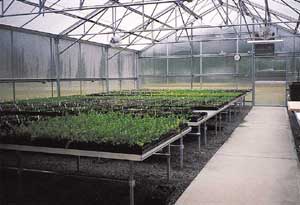 |
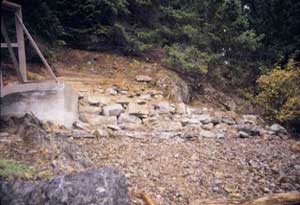 |
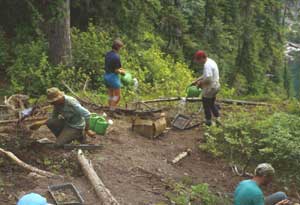 |
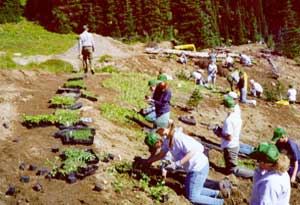 |
Restoration Ecology
Overiew
Restoration has been an important component of park management in the Pacific Northwest for the past twenty-five years. Early restoration programs focused on the subalpine zone where recreational use had caused extensive networks of informal trails and campsites. Initially, revegetation of these sites utilized both direct seeding and transplanted "plugs" of native species from adjacent undamaged plant communities. However, it soon became apparent that the number of plugs needed to restore damaged sites exceeded the number that could be salvaged from pristine areas without significantly degrading them. By the early 1980s, all three parks had built greenhouse facilities and were propagating native species for subalpine restoration. Over the last decade, restoration programs in North Cascades and Olympic have expanded into low elevation areas. Olympic has been restoring coastal areas near Sand Point, and North Cascades has initiated erosion control and restoration along the Ross Lake shoreline. Although Mount Rainier's program has remained concentrated in the subalpine zone, it has expanded to include restoration of aquatic ecosystems. Experimental removal of introduced fish was initiated in 1994 to investigate its effectiveness in restoring amphibian and invertebrate populations altered by the presence of the non-native fish. The largest and most comprehensive restoration program still lies ahead - restoration of the Elwha River ecosystem in Olympic National Park.
The goal of restoration in all three parks is to restore functioning ecosystems on damaged sites. In most instances, a reference stand is selected from an adjacent undamaged area with similar habitat characteristics. Detailed records are kept on plant and soil treatments used on each restored site, and many sites are monitored to evaluate the effectiveness of restoration efforts. Most monitoring has focused on cover or density of plant species and has documented high rates of transplant survival. Research is now needed to refine methods and to evaluate whether functioning ecosystems have been re-established.
Soils and Biota
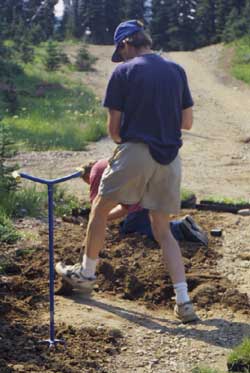
Background
Treatment of soils and monitoring of soil processes at restored sites
have generally been very limited. Early restoration efforts focused on
the practicality of propagating native plants and successfully
transplanting them in remote sites. Many sites were compacted, but did
not have much erosion. Transport of soil to backcountry sites is
expensive, logistically difficult, and potentially disruptive to park
visitors and wildlife, and before the 1980s, restoration programs did
not consider it feasible to import large quantities of soil. If sites
were eroded, peat was used to add organic matter and to help bring the
surface level of the sites back up to the original grade. Peat, rather
than soil, was selected for use at these sites based on the assumption
that lost organic matter needed to be replaced, and because peat is
lightweight and easy to carry. Recent evaluations of some early sites
seem to indicate that revegetation is failing because: 1) soil was not
added to the sites, and 2) too much peat was added, resulting in poorly
drained water-saturated soils unable to support heather meadows.
Historically, damaged sites in NOCA and OLYM have minor levels of erosion, and the manipulation of substrates during restoration efforts is minimal. Sites were scarified and sometimes amended with peat to restore organic matter content. Only recently, along Ross Lake has NOCA started to salvage soil (silt loam to scree) from the lake bottom to bring sites up to grade. However, at MORA severe erosion has long necessitated aggressive treatment of restoration sites. Prior to revegetation of these areas, sites are stabilized and filled to grade with soil, rock, and gravel to restore original topographic patterns. Sites less than 12" deep are filled with soil purchased from outside the park. The soil is custom mixed to match the organic matter content, soil texture, and pH of native soils, and it is steam-sterilized to reduce invasion by exotic plant species. On sites greater than 12" deep, a layer of gravel or rocks is added prior to the addition of soil. Generally, fertilizers are not used in any park because they may facilitate establishment of exotic species or reduce establishment of mycorrhizae.
Park Focus: MORA, NOCA, OLYM
Research Needs
Do the physical and chemical properties of restored sites change over
time? How do these soils compare to those in undamaged sites?
What invertebrates are present in undisturbed sites? What species are present in restored sites? Are there key species that can be used to assess the condition of restored sites?
What role do soil treatments play in the success of restoration projects? Is the addition of peat the best treatment of sites with minimal soil loss?
What is the minimum effective level of soil treatment on restoration sites?
Should soil treatment differ between coastal, lakeshore, and subalpine sites?
What affect does steam pasturization have on soil? Does this destroy native biota along with introduced seeds and pests?
If substrates are not amended, can plants be expected to survive? Specifically, are plants failing to thrive at Cascade Pass (NOCA) because soil was never added to eroded sites?
Rev. 9/2000
Mycorrhizae
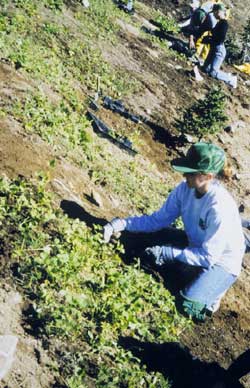
Background
Although mycorrhizal associations are known to be an important component
of plant associations, restoration programs in the three parks have
developed without specific data about or attention to these
associations. In some instances, native soil has been mixed into
greenhouse media to facilitate inoculation, but no monitoring has been
conducted to determine if inoculation has occurred. Most target species
have been propagated successfully and exhibited high survival rates when
transplanted in the field. However, we don't know if growth or survival
rates would have been higher with additional treatment. Most
restoration sites have been small, and we have assumed that mycorrhizae
will invade without our interference, but in the last five years, MORA
has restored some fairly large sites (1-5 acres) and the question of
unassisted inoculation has been raised. Questions that we are aware of
are listed below and are not meant to be all-inclusive.
Park Focus: MORA, NOCA, OLYM
Research Needs
What mycorrhizal species are associated with plant species used in
restoration? To what degree are these associations determined by site
characteristics versus host species?
How do mycorrhizal associations change with site? How many mycorrhizal species are found in our native plant communities?
During which stage of plant development does mycorrhizal inoculation need to occur? Are mycorrhizal species associated with seedling establishment the same as for mature communities?
How do our restoration practices affect or limit mycorrhizal infection of plants or habitats?
How does the size of the restoration site affect mycorrhizal innoculation?
How does inoculation affect short-term versus long-term success of restoration (i.e., are growth rates/root and shoot greater over the long-term)?
What are effective methods of site inoculation?
What is the genetic diversity of mycorrhizal species?
Should we consider innoculation of sites or during propagation activities?
Could our greenhouse operations be the source of new mycorrhizal species to field sites?
Rev. 9/2000
Seed Production and Plant Conditions
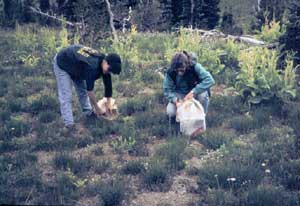
Background
Restoration sites in all plant communities are generally seeded and
planted with greenhouse plants or salvaged plants. Although we often
track the volumes of seed we use on these sites, we have not analyzed
existing data or experimented with different amounts of seed. We are
interested in research that will help increase our success in
revegetation by seed (on-site).
Park Focus: MORA, NOCA, OLYM
Research Needs
Do some species typically have mast years and can these be predicted
using climatic factors?
What are the germination and viability rates of species we propagate? How do these rates change over time with seed storage?
What are natural levels of seed rain in the plant communities of our sites?
What species and quantities of seeds are stored in seed banks?
Does the use of mulches limit seed rain to restoration sites?
How do mulches influence seed germination?
How do mulches affect soil temperatures, soil mositures, soil nitrogen levels, and mycorrhizae? Should we use different types of mulches at different elevations or different sites within each park?
What volumes of seeds are optimal for revegetation?
What species are most successfully seeded?
What is the condition of plants in restored sites? Are these species reproducing? Are root systems spreading?
How does watering influence plant survival? How long is watering needed to substantially increase survival or growth rates?
Rev. 9/2000
Greenhouse Practices
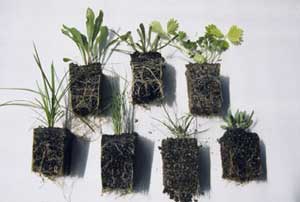
Background
All three parks use greenhouse propagated plants extensively within
their restoration programs. Greenhouse programs have become very
successful at growing plants, but we still wonder what influence our
plants have on native ecosystems and how we can become more
successful.
Park Focus: MORA, NOCA, OLYM
Research Needs
How do greenhouse practices influence the success of restoration
programs?
Do we introduce non-native invertebrates to restoration sites on greenhouse propagated plants?
How can horticultural practices improve field survival of greenhouse plants?
What are the effects of greenhouse preconditioning on field performance of native plants?
What are the effects of introduced soil components (e.g., perlite, vermiculite, pumice, sand) on native soil and invertebrates, mycorrhizae, water movement between native and imported soil, soil freezing and movement, root behavior?
Rev. 9/2000
Genetic Diversity
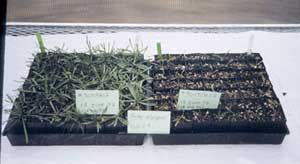
Background
National Park Service policies direct that we will strive to protect the
full range of genotypes by perpetuating natural processes and minimizing
our influence on these processes. Generally, once a restoration project
is initiated, we have already substantially altered extant communities
and interrupted natural processes. Most sites require active
revegetation either because of their size, the short growing season, or
to provide some evidence to visitors that the site is being restored.
Since active revegetation involves direct seeding or greenhouse plants,
knowledge of patterns of genetic diversity and the potential influence
our collection activities may have on these patterns is a high priority
for research. Currently, research has only been conducted on four
species of concern: Aster alpigenus, Carex spectablis, Phyllodoce
empetriformis, and P. glanduliflora.
Park Focus: MORA, NOCA, OLYM
Research Needs
What are the patterns of genetic diversity in species we propagate?
How does genetic diversity change across elevation, habitat, or distance gradients?
What adaptive variations do species used in restoration exhibit?
How do our restoration practices alter natural patterns of diversity?
At NOCA, what are the genetic diversity patterns of low-elevation plant species, used in restoration, along the Ross Lake shoreline? Can species be moved across the lake? How far should plant materials be moved up and down the lake?
Recent Research
Linhart, Y.B. and C. A. Wise. 1997. Genetic variability in populations
of revegetation candidate plants at Mt. Rainier National Park. Report
to the park, EPO, University of Colorado, Boulder, CO. 30 p.
Rochefort, R. M. 1995. Ecology and conservation of heather in Mount Rainier National Park. Ph.D. dissertation. University of Washington, Seattle, WA. 112 p.
Rev. 9/2000
Species Used in Restoration
| Species | Park of Interest | Elevation Range | |||
|---|---|---|---|---|---|
| MORA | NOCA | OLYM | low | mid-high | |
| Acer circinatum | X | X | |||
| A. glabrum | X | X | |||
| A. macrophyllum | X | X | |||
| Alnus rubra | X | X | |||
| Alnus sinuata | X | X | |||
| Amelanchier alnifolia | X | X | |||
| Anemone occidentalis | X | X | |||
| Antennaria lanata | X | X | |||
| Arctostaphylos uva-ursi | X | X | X | X | X |
| Aster alpigenus | X | X | |||
| Berberis aquifolium | X | X | |||
| B. nervosa | X | X | |||
| Betula papyrifera | X | X | |||
| Carex nigricans | X | X | X | X | |
| C. spectabilis | X | X | X | X | |
| Cassiope mertensiana | X | X | X | X | |
| Ceanothus sanguineus | X | X | |||
| Cornus nuttallii | X | X | |||
| Cornus stolonifera | X | X | |||
| Corylus cornuta | X | X | |||
| Deschampsia atropurpurea | X | X | |||
| Erigeron peregrinus | X | X | X | ||
| Festuca viridula | X | X | |||
| Gaultheria shallon | X | X | X | X | |
| Hieracium gracile | X | ||||
| Holodiscus discolor | X | X | |||
| Juncus drummondii | X | X | |||
| J. mertensianus | X | X | |||
| Leptarrhena pyrolifolia | X | X | X | ||
| Luetkea pectinata | X | X | X | X | |
| Luzula sp. | X | X | X | X | |
| Oemleria cerasiformis | X | X | |||
| Paxistima myrsinites | X | X | |||
| Philadelphus lewisii | X | X | |||
| Phleum alpinum | X | X | X | X | |
| Phyllodoce empetriformis | X | X | X | X | |
| P. glanduliflora | X | X | |||
| Polystichum munitum | X | X | |||
| Populus trichocarpa | X | X | |||
| Potentilla flabellifolia | X | X | X | X | |
| Prunus emarginata | X | X | |||
| Pseudotsuga menziesii | X | X | |||
| Ribes lacustre | X | X | |||
| Rubus leucodermis | X | X | |||
| Ribes sanguineum | X | X | |||
| Rhododendron albiflorum | X | X | X | X | |
| R. macrophyllum | X | X | |||
| R. groenlandicum | X | X | |||
| Rosa gymnocarpa | X | X | |||
| Rubus parviflorus | X | X | |||
| R. pedatus | X | X | |||
| R. spectabilis | X | X | |||
| R. ursinus | X | X | |||
| Salix scouleriana | X | X | |||
| Sambucus cerulea | X | X | |||
| S. racemosa | X | X | |||
| Spiraea betulifolia | X | X | |||
| S. densiflora | X | X | X | ||
| Symphoricarpos albus | X | X | |||
| Tsuga heterophylla | X | X | |||
| Thuja plicata | X | X | |||
| Vaccinium deliciosum | X | X | |||
| V. membranaceum | X | X | |||
| V. ovalifolium | X | X | |||
| V. ovatum | X | X | |||
| V. parvifolium | X | X | |||
| Veronica cusickii | X | X | |||
| Viburnum edule | X | X | |||
| Xerophyllum tenax | X | X | |||
Rev. 9/2000
Ecosystem Changes Resulting from Dam Removal
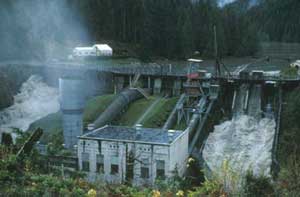
Background
The Elwha River Ecosystem and Fisheries Restoration Act (the Elwha Act)
of 1992 authorizes the Secretary of the Interior to acquire the Elwha
and Glines Canyon dams and to fully restore the river's ecosystem and
native anadromous fisheries. Olympic National Park is interested in
conducting research to document baseline ecosystem conditions in the
Elwha Basin and using these data to identify indicators for long-term
monitoring of changes in these conditions. This information would be
compared to data collected after the dams are removed to document
ecosystem responses to dam removal.
The Elwha and Glines Canyon Dams are located on the Elwha River, which flows on the Olympic Peninsula of northwestern Washington State. Elwha Dam was completed in 1913 at river mile (RM) 4.9, and includes a 108-foot-high concrete gravity section, gated spillways on both abutments, and a powerhouse with four generating units rated at a combined capacity of 14.8 megawatts (MW). Glines Canyon Dam was completed in 1927 at RM 13.4 and includes a 210-foot-high concrete thin arch section, a gated spillway on the left abutment, a thrust block on the right abutment, and a powerhouse with a single generating unit rated at 13.3 MW. Elwha Dam impounds Lake Aldwell, which has a surface area of 267 acres and a storage capacity of 8,100 acre-feet at elevation of 197.0 feet. Glines Canyon Dam impounds Lake Mills, which has a surface area of 415 acres and a storage capacity of 40,500 acre-feet at elevation of 590.33 feet. Both dams were acquired by the Federal government on February 29, 2000. They are being operated by the Bureau of Reclamation, with National Park Service oversight, until they are removed.
The Elwha River ecosystem and native anadromous fisheries will be restored through the removal of both dams and implementation of fisheries restoration and revegetation. The dams were installed without fish passage facilities on the Elwha River, so they obstruct upstream fish migration beyond the first 4.9 miles of the river. Before the dams were built, the Elwha River produced an estimated 380,000 anadromous (migrating) salmon and trout. Salmon and steelhead once filled over 70 miles of mainstem and tributary habitat in the Elwha. Their carcasses fed more than 22 species of wildlife and supplied the entire aquatic ecosystem with organic material, phosphorus and nitrogen. The construction of Elwha Dam blocked access to 93% of Elwha River habitat for these anadromous fish and began what became a precipitous decline in the native populations of all 10 runs of Elwha salmon and sea-going trout. Now, populations of primarily hatchery fish return to only the 4.9 miles of river below the Elwha Dam to spawn in crowded, unnatural and poor quality conditions. Both the terrestrial and aquatic ecosystems are less productive and varied as a result.
Park Focus: OLYM
Research Needs
Fish: Conduct population assessments (size, distribution,
genetic analyses) of Elwha River pink salmon and bull trout. Conduct
fish habitat (wetted area, woody debris, pool/riffle ratios) of the
river from Glines Canyon Dam to the river mouth (13 miles). Assess fish
community structure (species, population sizes) in upper, middle and
lower river.
Aquatic Invertebrates: Inventory aquatic invertebrates in upper (above Glines Dam), middle (between the two dams) and lower (below Elwha Dam) river.
Vegetation: Inventory riparian plant communities from the river mouth upstream to the historic limit of anadromous fish migration.
Water Quality: Compile existing information regarding temperatures, dissolved oxygen, etc., and initiate monitoring program for the upper, middle and lower river.
Sediment Transport and Stream Channel Morphology: Describe substrate composition, depth, channel width across representative transects from Glines Dam to the river mouth.
Marine and Estuarine Resources: Map the physical and biological features of the estuary and reservation beaches near the river mouth.
Wildlife: Conduct population surveys for osprey, red-tailed hawk, bald eagles, etc. Radio-tag elk to determine seasonal movements and migration patterns within river basin.
Rev. 9/2000
| <<< Previous | <<< Contents>>> | Next >>> |
research-catalog/restoration.htm
Last Updated: 05-Sep-2000